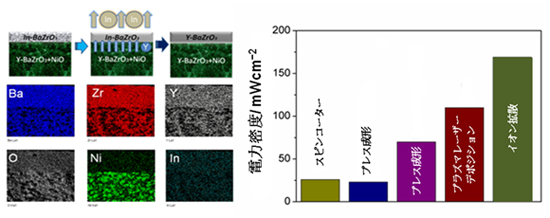Success in developing groundbreaking electrolyte materials
One step forward for commercialization of SOFC
2010.11.18
National Institute for Materials Science
Fuel Cell Nano-Materials Group, International Center for Materials Nanoarchitectonics has successfully developed two types of novel proton conducting oxide electrolytes for solid oxide fuel cells (SOFCs).
Abstract

Upper left: Schematic diagram of the procedure for preparing an anode supported BZY electrolyte film.Lower left: Elemental mapping, confirming the In3+ ions evaporation and Y3+ ions migration from the anode to the electrolyte layer, to occupy the In3+ sites.Right: Fuel cell performance of electrode-supported cells using BZY electrolytes prepared by different methods and measured at 600oC in the literature reports (spin-coating cell was tested at 800oC) as well as in the present study, indicating that the BZY cell in the present study shows the largest power density
